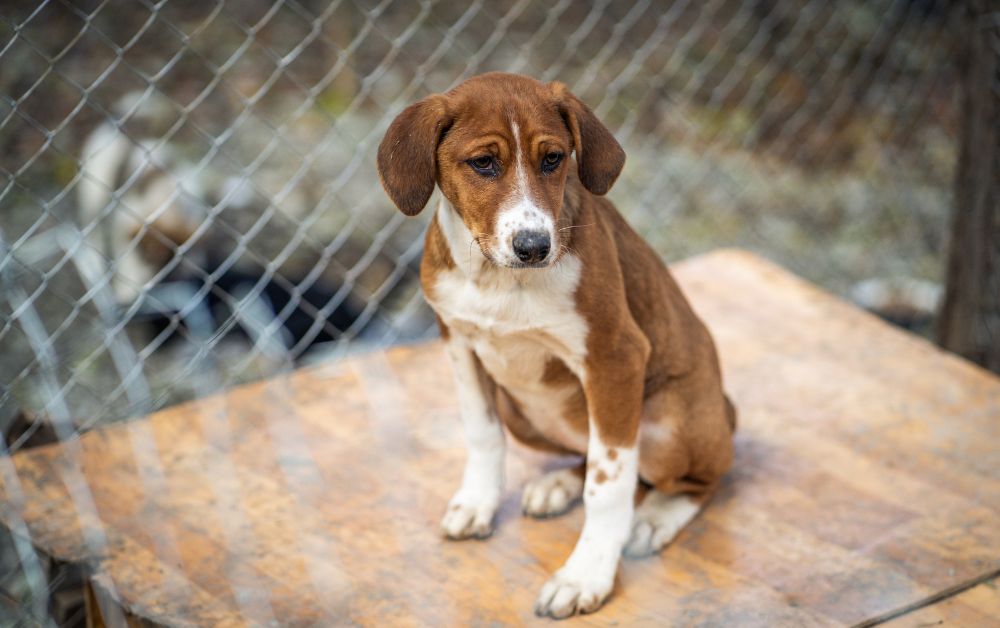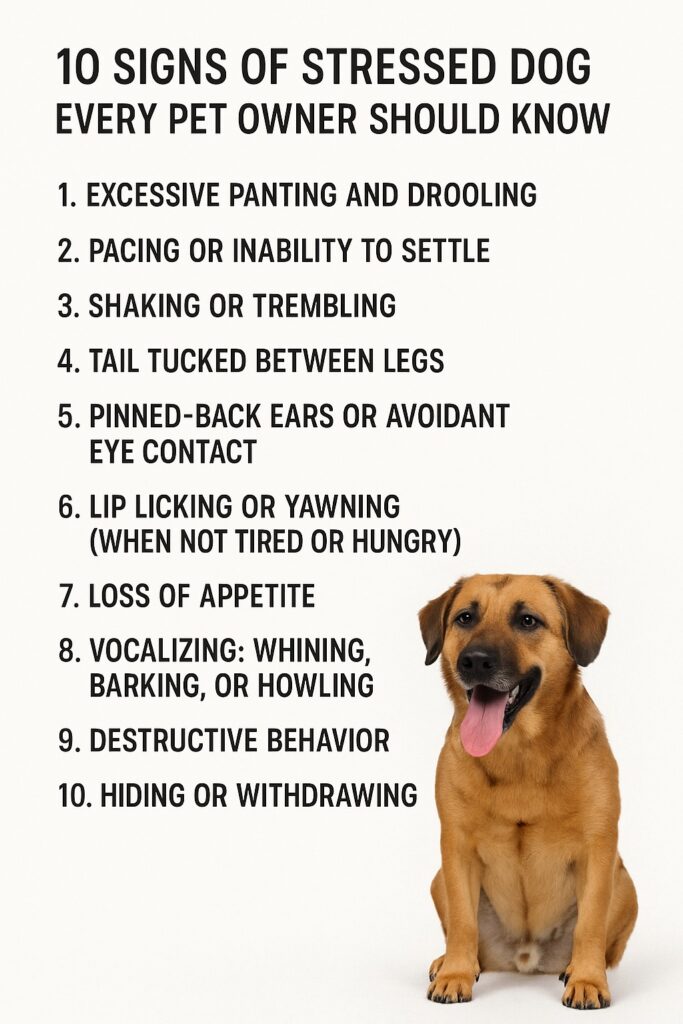Table of Contents
Dogs might not speak our language, but they’re constantly communicating. And when your pup is stressed, those signs can show up in subtle (and not-so-subtle) ways. Whether you’re a new dog owner or a lifelong pet parent, understanding canine stress signals is essential for keeping your furry friend healthy and happy.
In this guide, we’ll walk you through:
- What causes stress in dogs
- The top 10 signs to watch out for
- How to help your dog feel safe and relaxed
- Answers to common pet parent questions
Let’s dive in.

What Causes Stress in Dogs?
Just like humans, dogs experience stress due to emotional, environmental, and physical triggers. Some of the most common causes include:
- Separation from their owner
Many dogs suffer from separation anxiety, especially if they’re used to having someone around all day. - Loud noises
Fireworks, thunder, or even vacuum cleaners can make dogs feel overwhelmed and unsafe. - New environments
Moving to a new home, staying in a kennel, or meeting new people or animals can cause anxiety. - Inconsistent routines
Dogs thrive on predictability. Sudden changes in feeding time, walks, or your own schedule can be stressful. - Lack of exercise or stimulation
Boredom and pent-up energy can lead to restlessness and destructive behavior. - Trauma or past abuse
Rescue dogs may carry emotional scars from past neglect, which can cause stress in new situations.
Understanding these triggers is the first step in addressing your dog’s emotional needs.

10 Signs Every Pet Owner Should Know
Stress in dogs often shows up through changes in body language and behavior. Here are the top signs to look out for:
1. Excessive Panting and Drooling
While panting is normal after exercise or in the heat, dogs that pant heavily without exertion may be stressed. You might also notice increased drooling, especially in unfamiliar settings
2. Pacing or Inability to Settle
A stressed dog might pace back and forth, circle the room, or struggle to lie down and relax. This is often seen in dogs that are anxious about being left alone or encountering something unfamiliar.
3. Shaking or Trembling
If your dog is shaking but isn’t cold or wet, it could be a sign of stress. This is common during thunderstorms or vet visits and is especially noticeable in smaller or more sensitive breeds.
4. Tail Tucked Between Legs
A tucked tail signals fear, discomfort, or submission. It’s one of the clearest signs your dog isn’t feeling secure in the current environment.
5. Pinned-Back Ears or Avoidant Eye Contact
If your dog’s ears are pulled back and they avoid looking at you, this could indicate nervousness or unease. These subtle cues are easy to miss but they speak volumes.
6. Lip Licking or Yawning (When Not Tired or Hungry)
Dogs use these behaviors as calming signals. If your pup starts yawning frequently or licking their lips while nothing else is happening, they may be trying to cope with stress.
7. Loss of Appetite
Stress often leads to a lack of interest in food or treats. If your dog skips meals after a routine change or stressful event, monitor closely and consult your vet if it continues.
8. Vocalizing: Whining, Barking, or Howling
Increased vocalization especially when left alone can be a sign of emotional distress. Some dogs bark out of fear or whine when anticipating a stressful event.
9. Destructive Behavior
Chewing furniture, digging, or tearing up toys and pillows is often a stress response especially when paired with other signs like restlessness or separation anxiety.
10. Hiding or Withdrawing
If your normally social dog suddenly hides, avoids touch, or isolates themselves in a quiet space, it’s likely they’re feeling overwhelmed or scared.

How to Help a Stressed Dog
Once you’ve identified the signs, the next step is to create a calm and safe environment. Here’s how to support your dog:
1. Stick to a Routine
Dogs find comfort in predictability. Try to keep meal times, walks, and play sessions consistent.
2. Offer a Safe Space
Create a cozy, quiet place where your dog can retreat during stressful events (like thunderstorms or visitors). Crates with soft bedding often work well.
3. Exercise and Enrichment
A tired dog is a calm dog. Provide regular physical activity, as well as mental stimulation through puzzle toys, sniff walks, and games.
4. Use Calming Tools
Anxiety wraps, calming diffusers (like Adaptil), and dog-safe music can reduce stress in sensitive pups.
5. Stay Calm and Reassuring
Your tone and energy affect your dog. Speak gently, avoid yelling, and reward calm behavior with praise or treats.
6. Talk to Your Vet
If stress behaviors continue or worsen, consult a veterinarian. Your dog may benefit from professional behavior training or natural calming supplements.
Frequently Asked Questions
How can I tell the difference between stress and a medical issue?
If your dog’s behavior suddenly changes (like refusing to eat, constant licking, or aggression), it’s always best to rule out health problems with your vet first.
Can dogs develop long-term anxiety?
Yes. Dogs can develop generalized anxiety if stress is not addressed. Early intervention helps prevent escalation.
What breeds are more prone to stress?
High-energy or highly sensitive breeds such as Border Collies, German Shepherds, Chihuahuas, and Toy Poodles may show stress more visibly.
Should I comfort my dog when they’re scared, or will it reinforce the fear?
It’s a myth that comforting a fearful dog reinforces bad behavior. Comforting your dog builds trust and helps them feel secure.
Conclusion
Stress is part of life even for our dogs. But with a little awareness, empathy, and action, you can help your pup feel more secure and supported. Start by recognizing the signs, then take steps to build a calm, routine-driven environment.
Your dog depends on you and by tuning in to their needs, you’ll strengthen your bond and give them the emotional safety they deserve.

